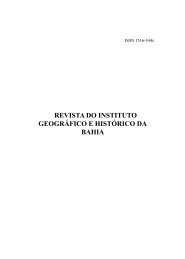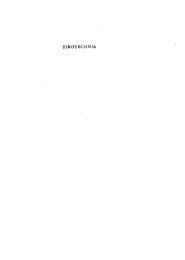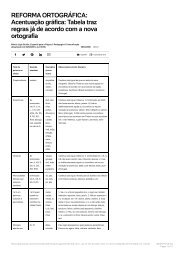Create successful ePaper yourself
Turn your PDF publications into a flip-book with our unique Google optimized e-Paper software.
Downloaded by [University of Illinois at Urbana-Champaign] at 06:35 10 March 2015
174 PORTUGUESE ROTEIROS, I500-I700
together with those of the crews entrusted to their care 1 • The
Roteiro of Andre Pires, written about I 5 I 8-24, is little more
than a copy of that of Joao de Lisboa, and does not need any
special mention.
IV. The next Roteiro cited by Commander da Costa is a
Livro de Rotear de Portugal para a India, which exists in Seville,
and which from various indications he assumes to be little more
than a modified copy of one of the above-mentioned Roteiros.
V. We now come to the first Roteiro dealing with Brazil.
This is the famous Roteiro do Brasil written by Pero Lopes de
Sousa in I 5 30-2, when accompanying his brother, the more
celebrated Martim Affonso de Sousa, on his voyage thither in
I 5 30. This Roteiro is a notable piece of work, and although the
original has long since disappeared, a copy of it was published
by Varnhagen at Lisbon in I 839 with the title Didrio da navega{ao
da armada, que foi a terra do Brazil em I 5 30 sob a capitania
mar de Martim Affonso de Souza, escrito por seu irmaff Pero Lopes
de Sousa. Incidentally Martim Affonso himself was also an
expert navigator 2 •
VI. The three well-known Roteiros of Dom Joao de Castro
deserve special mention, as marking a turning point in the
history of Portuguese nautical science. The first of these Roteiros
deals with the voyage from Lisbon to Goa in I 53 8, the second
with that from Goa to Diu in I 53 8-9, and the third with his
expedition to the Red Sea in I 541 3 . The depth of knowledge
which these works reveal is truly extraordinary, and nothing
seems to have escaped the keen perception of his scientific mind.
From the numerous observations which show his exceptional
value as a practical observer, Commander da Costa selects the
two following :
I. Because the needle of the compass varied on board ship,
when moved from one place to another, he concluded that this
was due to the fact that it had been placed near an iron cannon,
and that "the iron of the cannon attracted to itself the needle
I Dia!ogo do So/dado Pratico. Lisboa, 1798.
2 Cf. the documents printed on pp. 254--6 of Letters qf King John III of
Portugal, where Martim Affonso makes several interesting suggestions about the
sea route to India and alterations in the Roteiros.
3 First published in r88z, 1843 and 1833 respectively.


![[Cortar & Editat] Artigo - BOXER, C.R - Portuguese Roteiros, 1500-1700_removed](https://documents.yumpu.com/000/065/314/939/2e145b8f9d020cb1478f6bb669de4b853369b67c/574b7158624e37784b6d445a4f59594f6444506d52673d3d/4b4d584a6548782b7a4c5356796d694549436b2f32773d3d.jpg?AWSAccessKeyId=AKIAICNEWSPSEKTJ5M3Q&Expires=1715835600&Signature=sKLkvbCiA8csUb79RhTKkIOwOm0%3D)

![[Capa & Editar] Artigo - BARROS, Sigrid Porto de - A](https://documents.yumpu.com/000/063/816/786/af709ce29d1c721e5f74c145faeb760c1556c101/714f48715a616a2f324a556f537178394e6b4b4f54413d3d/45394b5a5354347734556b4a575634636c39565037413d3d.jpg?AWSAccessKeyId=AKIAICNEWSPSEKTJ5M3Q&Expires=1715835600&Signature=y2mCtotTok0YIrRsC6MEAJnTGb0%3D)



